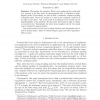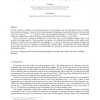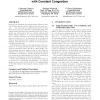233 search results - page 1 / 47 » Flows on Few Paths: Algorithms and Lower Bounds |
ESA
2004
Springer
13 years 10 months ago
2004
Springer
Abstract. Classical network flow theory allows decomposition of flow into several chunks of arbitrary sizes traveling through the network on different paths. In the first part ...
APPROX
2010
Springer
13 years 6 months ago
2010
Springer
We consider the question: What is the maximum flow achievable in a network if the flow must be decomposable into a collection of edgedisjoint paths? Equivalently, we wish to find a...
CORR
2011
Springer
12 years 12 months ago
2011
Springer
We consider the task of topology discovery of sparse random graphs using end-to-end random measurements (e.g., delay) between a subset of nodes, referred to as the participants. T...
DAM
1998
13 years 4 months ago
1998
We first consider so-called (1,+s)-branching programs in which along every consistent path at most s variables are tested more than once. We prove that any such program computing...
STOC
2006
ACM
14 years 5 months ago
2006
ACM
We study the maximum edge-disjoint paths problem in undirected planar graphs: given a graph G and node pairs s1t1, s2t2, . . ., sktk, the goal is to maximize the number of pairs t...



